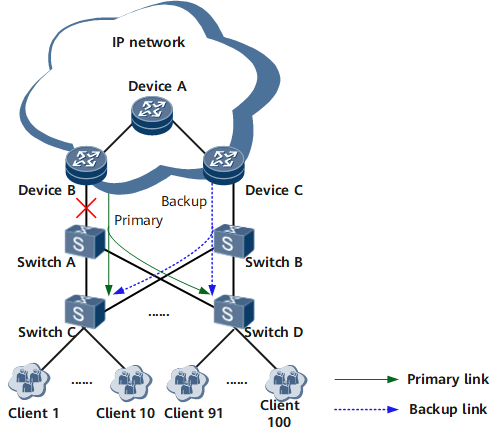NQA for Static Routes
Background
Static routes do not have a dedicated detection mechanism. If a link fails, a network administrator must manually delete the corresponding static route from the IP routing table. This process delays link switchovers and can cause lengthy service interruptions.
Bidirectional Forwarding Detection (BFD) for static routes can use BFD sessions to monitor the link status of a static route. However, both ends of the link must support BFD. Network quality analysis (NQA) for static routes, however, can monitor the link status of a static route as long as only one end supports NQA.
Table 1 compares BFD and NQA for static routes.
Item |
BFD for Static Routes |
NQA for Static Routes |
|---|---|---|
Detection mode |
Bidirectional session |
Unidirectional detection |
Requirements for communicating devices |
Two communicating devices; both must support BFD. |
Two communicating devices; only one must support NQA. |
Detection speed |
Millisecond-level |
Second-level |
Related Concepts
NQA monitors network quality of service (QoS) in real time. If a network fails, NQA can be used to diagnose the fault.
- success: The test is successful. NQA instructs the routing management module to set the static route to active and add the static route to the routing table.
- failed: The test fails. NQA instructs the routing management module to set the static route to inactive and delete the static route from the routing table.
- no result: The test is running and no result has been obtained, which does not change the status of the static route.

For NQA details, see the chapter "System Monitor" in the HUAWEI NetEngine 8000 F Series Router Feature Description.
Implementation
NQA for static routes associates an NQA test instance with a static route and uses the NQA test instance to monitor the link. The routing management module determines whether a static route is active or inactive based on the test result. If the static route is inactive, the routing management module deletes it from the IP routing table and selects a backup link for data forwarding, which prevents lengthy service interruptions.
In Figure 1, each access switch is connected to 10 clients, and a total of 100 clients are connected. Because no dynamic routing protocol can be deployed between Device B and the clients, static routes to the clients must be configured on Device B, and backup static routes to the clients can be configured on Device C.
Device A, Device B, and Device C run a dynamic routing protocol and learn routes from one another. Device B and Device C are configured to import static routes to the routing table of the dynamic routing protocol, and different costs are set for the static routes. Device A can contact Device B and Device C using the dynamic routing protocol to learn routes to the clients. Device A selects one primary link and one backup link based on link costs.
NQA for static routes, configured on Device B, uses NQA test instances to monitor the status of the primary link. If the primary link fails, the corresponding static route is deleted and network-to-client traffic switches to the backup link. When both the primary and backup links are running properly, network-to-client traffic is preferentially transmitted along the primary link.
Usage Scenario
NQA for static routes applies to a network on which BFD for static routes cannot be deployed due to device connectivity limitations. For example, switches, optical line terminals (OLTs), digital subscriber line access multiplexers (DSLAMs), multiservice access nodes (MSANs), or x digital subscriber lines (xDSLs) exist on the network.
Benefits
NQA for static routes can monitor the link status of static routes and implement rapid primary/backup link switchovers, preventing lengthy service interruptions.
